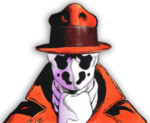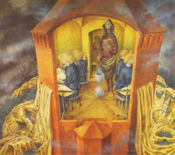Difference between revisions of "Chapter 1"
(Kazoo Concerto) |
|||
| Line 51: | Line 51: | ||
a: 17, b: 8 - '''LSD-25, mescaline, psilocybin'''<br /> | a: 17, b: 8 - '''LSD-25, mescaline, psilocybin'''<br /> | ||
| − | These hallucinogenic drugs are also mentioned in [http://gravitys-rainbow.pynchonwiki.com/wiki/ ''Gravity's Rainbow'']. It remains an open question as to whether and to what extent Pynchon took or was influenced by them. ("whether"? ...) [http:// | + | These hallucinogenic drugs are also mentioned in [http://gravitys-rainbow.pynchonwiki.com/wiki/ ''Gravity's Rainbow'']. It remains an open question as to whether and to what extent Pynchon took or was influenced by them. ("whether"? ...) [http://web.clas.ufl.edu/users/agordon/pynchon.htm ...] |
[[Image:rorschach1.jpg|150px|thumb|right|The first of the ten cards in the Rorschach inkblot test]] | [[Image:rorschach1.jpg|150px|thumb|right|The first of the ten cards in the Rorschach inkblot test]] | ||
Revision as of 21:34, 23 March 2007
- Please keep these annotations SPOILER-FREE by not revealing information from later pages in the novel.
| If your edition has 183 pages, follow the pages marked a: | If your edition has 152 pages, follow b: |
</br>
a: 9, b: ? - Oedipa
I think you have to pronounce the name American fashion, ED-i-pa, not British fashion, EED-i-pa, because Mucho uses the short form "Oed," which almost has to be ED.
a: 10, b: 1 - Mazatlán
a Mexican city on Mexico's Pacific coast. Pynchon lived in Mexico during parts of the 1960s.
a: 10, b: 1 - Cornell University
Pynchon's alma mater.
a: 10, b: 1 - Jay Gould
(1836 – 1892) was an American financier, who became a leading American railroad builder and speculator. In his lifetime and for a century after, Gould had a firm reputation as the most unethical of the 19th century American businessmen known as robber barons. Wikipedia
a: 10, b: 2 - Warpe, Wistfull, Kubitschek and McMingus
As Pynchon is a lifelong Jazz fan, the final name could be a nod to jazz legend Charles Mingus.
a: 10, b: 2 - Kinneret-Among-The-Pines
Fictional California town. Kinneret is the modern Hebrew name for the Sea of Galilee in Israel, upon the shores of which much of ministry of Jesus occurred.
a: 10, b: 2 - settecento
Settecento is the Italian word for seven hundred, and is the standard Italian term for the 18th century (not the 17th century, but the years beginning with 17). In English, it refers to styles of that period.
a: 10, b: 2 - Vivaldi Kazoo Concerto
Kazoos appear in Gravity's Rainbow. The title isn't as outlandish as it may seem; Vivaldi's concerti are often performed on instruments they were not written for. Example: concerto for two cellos recast for bassoon trio.
a: 10, b: 2 - Boyd Beaver
The name sounds suspiciously similar to Zoyd Wheeler, the protagonist of Vineland.
a: 11, b: 2 - Wendell ("Mucho") Maas
"Mucho más" is common Spanish phrase, meaning "much more."
a: 11, b: 2 - Pachuco dialect
Pachucos were Mexican American youth who developed their own subculture during the 1930s and 1940s in the Southwestern United States. They wore distinctive clothes (such as Zoot Suits) and spoke their own dialect (Caló). Wikipedia Zoot suits appear a few times in Gravity's Rainbow.
a: 11, b: 2 - chingas and maricones
Spanish slang for "fuck" and "faggot".
a: 11, b: 3 - Lamont Cranston
One identity adopted by The Shadow, a character of pulp fiction, radio shows, and comic books. Cranston was a wealthy young man about town. Wikipedia
a: 11, b: 3 - Commissioner Weston... Professor Quackenbush
?
American actor (1925-2001). He became a favorite actor of director Billy Wilder, starring in his films Some Like It Hot, The Apartment and others. Wilder felt Lemmon had a natural tendency toward overacting that had to be tempered; the Wilder biography Nobody's Perfect quotes the director as saying: "Lemmon, I would describe him as a ham, a fine ham, and with ham you have to trim a little fat." Wikipedia
a: 16, b: ? - Dr. Hilarius, her shrink or psychotherapist
Shrink is a shortened form of headshrinker, which is 50s slang. The OED cites 'shrink' in this text of 1966, as the first recorded written use of it as a slang term. Which must be why Pynchon defined it in the text.
a: 17, b: 8 - LSD-25, mescaline, psilocybin
These hallucinogenic drugs are also mentioned in Gravity's Rainbow. It remains an open question as to whether and to what extent Pynchon took or was influenced by them. ("whether"? ...) ...
a: 18, b: 8 - Rorschach blot
The Rorschach inkblot test (Pronounced roar-shock) is a method of psychological evaluation. Psychologists use this test to try to examine the personality characteristics and emotional functioning of their patients. Wikipedia
a: 18, b: 8 - a face is symmetrical like a Rorschach blot
In the graphic novel, Watchmen, written by Alan Moore, there is a character named Rorschach who wears a mask with a Rorscach blot on the front. Moore is a self-professed Pynchon fan: he referenced V. in V for Vendetta and has mentioned Gravity's Rainbow in interview. It is possible, not to say probable, that Moore was inspired by this line.
a: 18, b: 8 - TAT picture
The TAT is popularly known as the picture interpretation technique because it uses a standard series of 31 provocative yet ambiguous pictures about which the subject must tell a story. It was developed by American psychologists in the 1930s. Wikipedia
a: 18, b: 9 - Fu-Manchu
Dr. Fu Manchu is a fictional character, an evil genius of Chinese origin, first featured in a series of novels by Birmingham author Sax Rohmer during the first half of the 20th century. Wikipedia
a: 18, b: 9 - Perry Mason
Perry Mason is a fictional defense attorney who originally appeared in detective fiction by Erle Stanley Gardner. Mason was portrayed by Raymond Burr in a television series which ran on CBS from 1957 to 1966. The typical plot involves Perry Mason unmasking the actual murderer in a final dramatic courtroom showdown. Wikipedia
a: 19, b: 9 - The Profession v. Perry Mason...
Roseman may be trying to undermine Perry Mason by arguing that the dramatic courtroom twists in the TV show are actually uncommon in the American legal system.
a: 21, b: 11 - Bornando el Manto Terrestre
Remedios Varo (1908 - 1963) was a surrealist painter. Wikipedia
Bill Brown notes that "Pynchon saw Bordando el Manto Terrestre when, as part of the first full retrospective of the painter's work, it was displayed at the Palacio de Bellas Artes in Mexico City in 1964, a year after her death at the age of 55. Painted in 1961, el Manto (oil on masonite, roughly 40 by 48 inches) is the central panel in an autobiographical triptych. It is possible that Pynchon, writing Lot 49 in 1965, recalled the painting from memory or incomplete notes, and not with a reproduction of it set in front of him. He gets a lot wrong."
a:21, b:11 - she wore dark green bubble shades
This is the sixties, after all...
| Chapter 1 | Chapter 2 | Chapter 3 | Chapter 4 | Chapter 5 | Chapter 6 |
|---|




